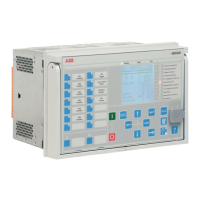In this case, the resistive part of the measured admittance is due to leakage losses
of the protected feeder. As they are typically very small, the resistive part is close
to zero. Due to inaccuracies in the voltage and current measurement, the small
real part of the apparent neutral admittance may appear positive. This should be
considered in the setting of the admittance characteristic.
Fault in the forward direction, that is, inside the protected feeder.
Unearthed network:
(Equation 31)
≈ ⋅
−
j
I I
U
eTot eFd
ph
(Equation 32)
Compensated network:
(Equation 33)
≈
+ ⋅ ⋅ −
( )
−
( )
I j I K I
U
Rcc eTot eFd
ph
1
(Equation 34)
High-resistance earthed network:
(Equation 35)
≈
+ ⋅ −
( )
I j I I
U
Rn eTot eFd
ph
(Equation 36)
Y
Bgtot
Sum of the phase-to-earth admittances ( Y
BgA
, Y
BgB
, Y
BgC
) of the background
network
Y
CC
Admittance of the earthing arrangement (compensation coil and parallel resistor)
I
Rcc
Rated current of the parallel resistor
I
eFd
Magnitude of the earth-fault current of the protected feeder when the fault resist-
ance is zero ohm
I
eTot
Magnitude of the uncompensated earth-fault current of the network when Rf is
zero ohm
K Compensation degree, K = 1 full resonance, K<1 undercompensated, K>1 overcom-
pensated
I
Rn
Rated current of the neutral earthing resistor
Protection functions 1MRS757644 H
434 620 series
Technical Manual

